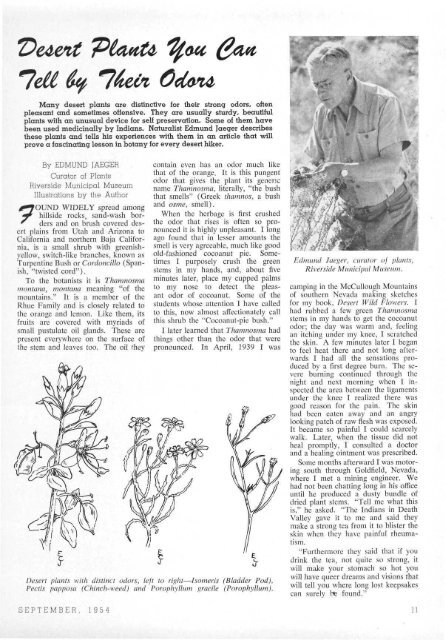World's largest catalog of jewelry parts - Desert Magazine of the ...
World's largest catalog of jewelry parts - Desert Magazine of the ...
World's largest catalog of jewelry parts - Desert Magazine of the ...
You also want an ePaper? Increase the reach of your titles
YUMPU automatically turns print PDFs into web optimized ePapers that Google loves.
<strong>Desert</strong> Plants You Can<br />
Tell by Their Odors<br />
Many desert plants are distinctive for <strong>the</strong>ir strong odors, <strong>of</strong>ten<br />
pleasant and sometimes <strong>of</strong>fensive. They are usually sturdy, beautiful<br />
plants with an unusual device for self preservation. Some <strong>of</strong> <strong>the</strong>m have<br />
been used medicinally by Indians. Naturalist Edmund Jaeger describes<br />
<strong>the</strong>se plants and tells his experiences with <strong>the</strong>m in an article that will<br />
prove a fascinating lesson in botany for every desert hiker.<br />
By EDMUND JAEGER<br />
Curator <strong>of</strong> Plants<br />
Riverside Municipal Museum<br />
Illustrations by <strong>the</strong> Author<br />
WIDELY spread among<br />
hillside rocks, sand-wash borders<br />
and on brush covered desert<br />
plains from Utah and Arizona to<br />
California and nor<strong>the</strong>rn Baja California,<br />
is a small shrub with greenishyellow,<br />
switch-like branches, known as<br />
Turpentine Bush or Cordoncillo (Spanish,<br />
"twisted cord").<br />
To <strong>the</strong> botanists it is Thamnosma<br />
montana, montana meaning "<strong>of</strong> <strong>the</strong><br />
mountains." It is a member <strong>of</strong> <strong>the</strong><br />
Rhue Family and is closely related to<br />
<strong>the</strong> orange and lemon. Like <strong>the</strong>m, its<br />
fruits are covered with myriads <strong>of</strong><br />
small pustulate oil glands. These are<br />
present everywhere on <strong>the</strong> surface <strong>of</strong><br />
<strong>the</strong> stem and leaves too. The oil <strong>the</strong>y<br />
contain even has an odor much like<br />
that <strong>of</strong> <strong>the</strong> orange. It is this pungent<br />
odor that gives <strong>the</strong> plant its generic<br />
name Thamnosma, literally, "<strong>the</strong> bush<br />
that smells" (Greek thamnos, a bush<br />
and osme, smell).<br />
When <strong>the</strong> herbage is first crushed<br />
<strong>the</strong> odor that rises is <strong>of</strong>ten so pronounced<br />
it is highly unpleasant. I long<br />
ago found that in lesser amounts <strong>the</strong><br />
smell is very agreeable, much like good<br />
old-fashioned cocoanut pie. Sometimes<br />
I purposely crush <strong>the</strong> green<br />
stems in my hands, and, about five<br />
minutes later, place my cupped palms<br />
to my nose to detect <strong>the</strong> pleasant<br />
odor <strong>of</strong> cocoanut. Some <strong>of</strong> <strong>the</strong><br />
students whose attention I have called<br />
to this, now almost affectionately call<br />
this shrub <strong>the</strong> "Cocoanut-pie bush."<br />
I later learned that Thamnosma had<br />
things o<strong>the</strong>r than <strong>the</strong> odor that were<br />
pronounced. In April, 1939 I was<br />
<strong>Desert</strong> plants with distinct odors, left to right—Isomeris (Bladder Pod),<br />
Pectis papposa (Chinch-weed) and Porophyllum gracile (Porophyllum).<br />
Edmund Jaeger, curator <strong>of</strong> plants,<br />
Riverside Municipal Museum.<br />
camping in <strong>the</strong> McCullough Mountains<br />
<strong>of</strong> sou<strong>the</strong>rn Nevada making sketches<br />
for my book, <strong>Desert</strong> Wild Flowers. I<br />
had rubbed a few green Thamnosma<br />
stems in my hands to get <strong>the</strong> cocoanut<br />
odor; <strong>the</strong> day was warm and, feeling<br />
an itching under my knee, I scratched<br />
<strong>the</strong> skin. A few minutes later I began<br />
to feel heat <strong>the</strong>re and not long afterwards<br />
I had all <strong>the</strong> sensations produced<br />
by a first degree burn. The severe<br />
burning continued through <strong>the</strong><br />
night and next morning when I inspected<br />
<strong>the</strong> area between <strong>the</strong> ligaments<br />
under <strong>the</strong> knee I realized <strong>the</strong>re was<br />
good reason for <strong>the</strong> pain. The skin<br />
had been eaten away and an angry<br />
looking patch <strong>of</strong> raw flesh was exposed.<br />
It became so painful I could scarcely<br />
walk. Later, when <strong>the</strong> tissue did not<br />
heal promptly, I consulted a doctor<br />
and a healing ointment was prescribed.<br />
Some months afterward I was motoring<br />
south through Goldfield, Nevada,<br />
where I met a mining engineer. We<br />
had not been chatting long in his <strong>of</strong>fice<br />
until he produced a dusty bundle <strong>of</strong><br />
dried plant stems. "Tell me what this<br />
is," he asked. "The Indians in Death<br />
Valley gave it to me and said <strong>the</strong>y<br />
make a strong tea from it to blister <strong>the</strong><br />
skin when <strong>the</strong>y have painful rheumatism.<br />
"Fur<strong>the</strong>rmore <strong>the</strong>y said that if you<br />
drink <strong>the</strong> tea, not quite so strong, it<br />
will make your stomach so hot you<br />
will have queer dreams and visions that<br />
will tell you where long lost keepsakes<br />
can surely be found."<br />
SEPTEMBER, 1954 11

















